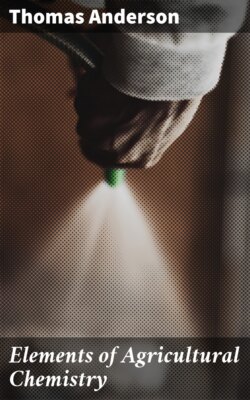Читать книгу Elements of Agricultural Chemistry - Thomas Anderson - Страница 12
На сайте Литреса книга снята с продажи.
THE PROXIMATE CONSTITUENTS OF PLANTS.
ОглавлениеTable of Contents
The substances absorbed by the plant, which are of simple composition, and contain only two elements, are elaborated within it, and converted into the many complicated compounds of which its mass is composed. Some of these, as, for example, the colouring matters of madder and indigo, the narcotic principle of the poppy, &c., are confined to a single species, or small group of plants, while others are found in all plants, and form the main bulk of their tissues. The latter are the only substances which claim notice in a treatise like the present. They have been divided into three great classes, of widely different properties, composition, and functions.
1st. The Saccharine and Amylaceous Constituents.—These substances are compounds of carbon, hydrogen, and oxygen, and all possess a certain degree of similarity in composition, the quantities of hydrogen and oxygen they contain being always in the proportion required to form water, so that they may be considered as compounds of carbon and water; not that it can be asserted that they actually do contain water, as such, for of that there is no evidence, but only that its elements are present in the proportion to form it.
Cellulose.—This substance forms the fundamental part of all plants. It is the principal constituent of woody fibre, and is found in a state of purity in the fibre of cotton and flax, and in the pith of plants; but in wood it is generally contaminated with another substance, which has received the name incrusting matter, because it is deposited in and around the cells of which the plant is in part composed. Cellulose is insoluble in all menstrua, but, when boiled for a long time with sulphuric acid, is converted into a substance called dextrine. Cellulose consists of—
| From pith of Elder-tree. | Spongioles of roots. | |
| Carbon | 43·37 | 43·00 |
| Hydrogen | 6·04 | 6·18 |
| Oxygen | 50·59 | 50·82 |
| ——— | ——— | |
| 100·00 | 100·00 |
It is represented chemically by the formula, C24H21O21, which shows it to be a compound of 24 atoms of carbon with 21 of hydrogen and 21 of oxygen.
Incrusting matter.—Large quantities of this substance enter into the composition of all plants. Of its chemical nature little is known, as it cannot be obtained separate from cellulose, but it is analogous to that substance in its composition, and probably contains hydrogen and oxygen in the proportion to form water.
Starch.—Starch is one of the most abundant constituents of plants, and is found in most seeds, as those of the cereals and the leguminous plants; in the tubers of the potatoe, the bulbs of tulips, &c. &c. It is obtained by placing a quantity of wheat flour in a bag, and kneading it under a gentle stream of water. When the water is allowed to stand, it deposits the starch as a fine white powder, which, when examined by the microscope, is found to be composed of minute grains, formed of concentric layers deposited on one another. These grains vary considerably in size and structure in different plants; but in the same plant they are generally so much alike as to admit of their recognition by a practised observer. They were formerly believed to be composed of an external coating of a substance insoluble in water, and containing in their interior a soluble kernel; but this opinion has been refuted, and distinct evidence been brought to show that the exterior and interior of the globules are identical in chemical properties. Starch is insoluble in cold water, but by boiling, it dissolves, forming a thick paste. By long continued boiling with water containing a small quantity of acid, it is completely dissolved and converted into dextrine, and eventually into sugar. The same change is produced by the action of fermenting substances, such as the extract of malt; when heated in the dry state to a temperature of about 390 Fahr., it becomes soluble in cold water. It is distinguished by giving a brilliant blue compound with iodine. Starch contains—
